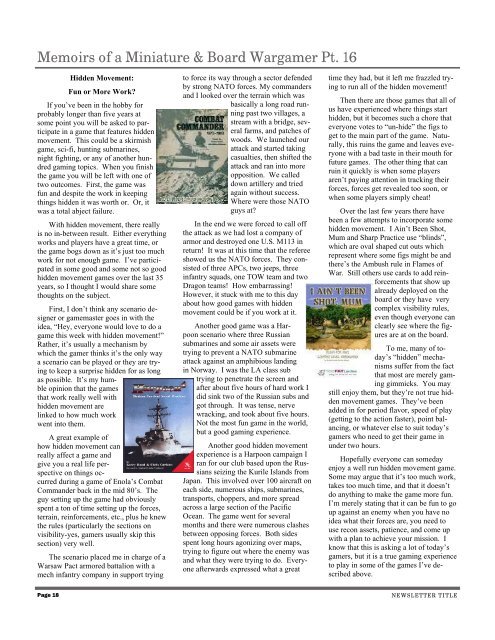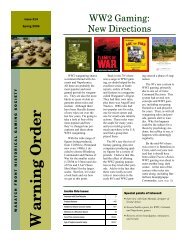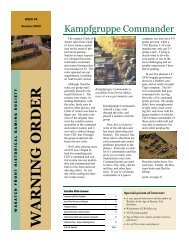Warning Order - Wasatch Front Historical Gaming Society
Warning Order - Wasatch Front Historical Gaming Society
Warning Order - Wasatch Front Historical Gaming Society
You also want an ePaper? Increase the reach of your titles
YUMPU automatically turns print PDFs into web optimized ePapers that Google loves.
Memoirs of a Miniature & Board Wargamer Pt. 16<br />
Hidden Movement:<br />
Fun or More Work?<br />
If you’ve been in the hobby for<br />
probably longer than five years at<br />
some point you will be asked to participate<br />
in a game that features hidden<br />
movement. This could be a skirmish<br />
game, sci-fi, hunting submarines,<br />
night fighting, or any of another hundred<br />
gaming topics. When you finish<br />
the game you will be left with one of<br />
two outcomes. First, the game was<br />
fun and despite the work in keeping<br />
things hidden it was worth or. Or, it<br />
was a total abject failure.<br />
With hidden movement, there really<br />
is no in-between result. Either everything<br />
works and players have a great time, or<br />
the game bogs down as it’s just too much<br />
work for not enough game. I’ve participated<br />
in some good and some not so good<br />
hidden movement games over the last 35<br />
years, so I thought I would share some<br />
thoughts on the subject.<br />
First, I don’t think any scenario designer<br />
or gamemaster goes in with the<br />
idea, “Hey, everyone would love to do a<br />
game this week with hidden movement!”<br />
Rather, it’s usually a mechanism by<br />
which the gamer thinks it’s the only way<br />
a scenario can be played or they are trying<br />
to keep a surprise hidden for as long<br />
as possible. It’s my humble<br />
opinion that the games<br />
that work really well with<br />
hidden movement are<br />
linked to how much work<br />
went into them.<br />
A great example of<br />
how hidden movement can<br />
really affect a game and<br />
give you a real life perspective<br />
on things occurred<br />
during a game of Enola’s Combat<br />
Commander back in the mid 80’s. The<br />
guy setting up the game had obviously<br />
spent a ton of time setting up the forces,<br />
terrain, reinforcements, etc., plus he knew<br />
the rules (particularly the sections on<br />
visibility-yes, gamers usually skip this<br />
section) very well.<br />
The scenario placed me in charge of a<br />
Warsaw Pact armored battalion with a<br />
mech infantry company in support trying<br />
to force its way through a sector defended<br />
by strong NATO forces. My commanders<br />
and I looked over the terrain which was<br />
basically a long road running<br />
past two villages, a<br />
stream with a bridge, several<br />
farms, and patches of<br />
woods. We launched our<br />
attack and started taking<br />
casualties, then shifted the<br />
attack and ran into more<br />
opposition. We called<br />
down artillery and tried<br />
again without success.<br />
Where were those NATO<br />
guys at?<br />
In the end we were forced to call off<br />
the attack as we had lost a company of<br />
armor and destroyed one U.S. M113 in<br />
return! It was at this time that the referee<br />
showed us the NATO forces. They consisted<br />
of three APCs, two jeeps, three<br />
infantry squads, one TOW team and two<br />
Dragon teams! How embarrassing!<br />
However, it stuck with me to this day<br />
about how good games with hidden<br />
movement could be if you work at it.<br />
Another good game was a Harpoon<br />
scenario where three Russian<br />
submarines and some air assets were<br />
trying to prevent a NATO submarine<br />
attack against an amphibious landing<br />
in Norway. I was the LA class sub<br />
trying to penetrate the screen and<br />
after about five hours of hard work I<br />
did sink two of the Russian subs and<br />
got through. It was tense, nerve<br />
wracking, and took about five hours.<br />
Not the most fun game in the world,<br />
but a good gaming experience.<br />
Another good hidden movement<br />
experience is a Harpoon campaign I<br />
ran for our club based upon the Russians<br />
seizing the Kurile Islands from<br />
Japan. This involved over 100 aircraft on<br />
each side, numerous ships, submarines,<br />
transports, choppers, and more spread<br />
across a large section of the Pacific<br />
Ocean. The game went for several<br />
months and there were numerous clashes<br />
between opposing forces. Both sides<br />
spent long hours agonizing over maps,<br />
trying to figure out where the enemy was<br />
and what they were trying to do. Everyone<br />
afterwards expressed what a great<br />
time they had, but it left me frazzled trying<br />
to run all of the hidden movement!<br />
Then there are those games that all of<br />
us have experienced where things start<br />
hidden, but it becomes such a chore that<br />
everyone votes to “un-hide” the figs to<br />
get to the main part of the game. Naturally,<br />
this ruins the game and leaves everyone<br />
with a bad taste in their mouth for<br />
future games. The other thing that can<br />
ruin it quickly is when some players<br />
aren’t paying attention in tracking their<br />
forces, forces get revealed too soon, or<br />
when some players simply cheat!<br />
Over the last few years there have<br />
been a few attempts to incorporate some<br />
hidden movement. I Ain’t Been Shot,<br />
Mum and Sharp Practice use “blinds”,<br />
which are oval shaped cut outs which<br />
represent where some figs might be and<br />
there’s the Ambush rule in Flames of<br />
War. Still others use cards to add reinforcements<br />
that show up<br />
already deployed on the<br />
board or they have very<br />
complex visibility rules,<br />
even though everyone can<br />
clearly see where the figures<br />
are at on the board.<br />
To me, many of today’s<br />
“hidden” mechanisms<br />
suffer from the fact<br />
that most are merely gaming<br />
gimmicks. You may<br />
still enjoy them, but they’re not true hidden<br />
movement games. They’ve been<br />
added in for period flavor, speed of play<br />
(getting to the action faster), point balancing,<br />
or whatever else to suit today’s<br />
gamers who need to get their game in<br />
under two hours.<br />
Hopefully everyone can someday<br />
enjoy a well run hidden movement game.<br />
Some may argue that it’s too much work,<br />
takes too much time, and that it doesn’t<br />
do anything to make the game more fun.<br />
I’m merely stating that it can be fun to go<br />
up against an enemy when you have no<br />
idea what their forces are, you need to<br />
use recon assets, patience, and come up<br />
with a plan to achieve your mission. I<br />
know that this is asking a lot of today’s<br />
gamers, but it is a true gaming experience<br />
to play in some of the games I’ve described<br />
above.<br />
Page 18<br />
NEWSLETTER TITLE







